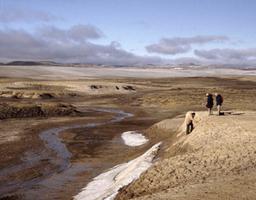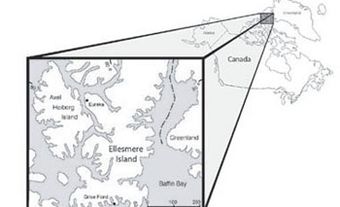FOSSIL bones were first discovered in 1978 in the rocks formed in the now vanished Haughton Lake. Subsequent palaeontological investigations between 1979 and 2007 produced an assemblage of lacustrine and terrestrial plants and animals that provide a window on early Miocene life at this high latitude. Fossil fishes are well represented in the lake sediments, by several kinds including trout and a smeltlike form. A record of at least one bird, a relative of the swan, is somewhat surprising, for swans no longer occur this far north. Mammals are diverse in size and kind. The smallest is a tiny shrew. Rabbits are very numerous, indicating the presence of many of these animals around the lake. A small carnivore and a rodent are represented by one specimen each. At least one kind of rhinoceros is known from a nearly complete skull and skeleton. This was a relatively short rhino, heavily built and with short legs and spreading toes on stubby feet. A small, deerlike animal with very complex teeth that suggest a diet of abrasive plant material is also represented. The shrew and the rabbit appear to have relatives from the mid-latitudes, but the rhinoceros and the deer are unique and probably represent evolution of their lineages at high latitudes.
Abundant fossil pollen and rare plant macrofossils from the rocks of the Haughton Formation provide evidence on the local environmental conditions around Haughton Lake when these fishes, birds and mammals lived there. A forested environment with ample understory (ie, an underlying layer of vegetation) of smaller trees and shrubs is suggested. The fossil pollen of trees shows that larches and alder were dominant and that spruce, fir, pine, birch, chestnut, and sweetgum were present. Grasses were absent or very rare. Comparison of this plant assemblage with living plants suggests that in the early Miocene a humid, cool temperate, probably coastal climate with severe winters prevailed on northern Devon Island, making it roughly comparable to New Jersey today (seeCLIMATE CHANGE). The fossils from the Haughton Formation provide a unique view of life at high latitudes about 23 million years ago, and supply many facts pertinent to understanding evolutionary developments, animal and plant biogeography, climate change and geologic history from a high northern region that is very different today.

 Share on Facebook
Share on Facebook Share on X
Share on X Share by Email
Share by Email Share on Google Classroom
Share on Google Classroom





